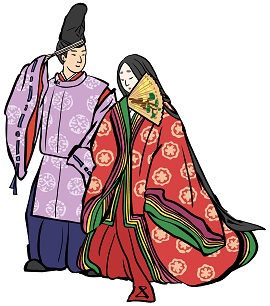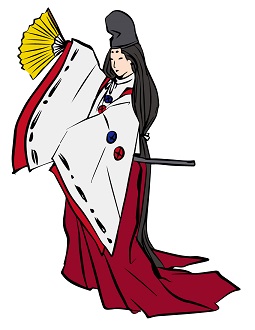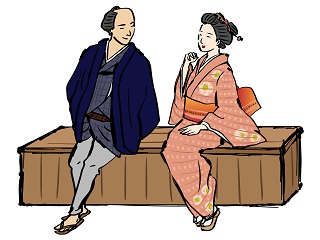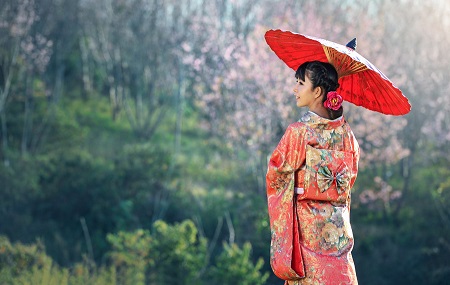The History of Kimono(着物の歴史)
The word “kimono” originally means “garment” in Japanese, but in recent years it has come to mean “traditional Japanese clothing.
It is said that it was not until the Heian period (794-1185) that the kimono as we wear it today was created.
Prior to that, in ancient times through the Nara period (710-794), trouser-type garments, skirt-type garments combined with an upper garment,
or one-piece(dress) garments were the norm.
「着物」は本来、日本語で衣服という意味ですが、近年では「日本の伝統的な衣服」という意味で使われています。
現在着られているような形の着物が生まれたのは平安時代(794年〜1185年)になってからのことと言われています。
それ以前の古代から奈良時代(710年〜794年)にかけては、ズボン型の衣服、あるいはスカート型の衣服と上衣の組み合わせか、ワンピース型の衣服が主流でした。
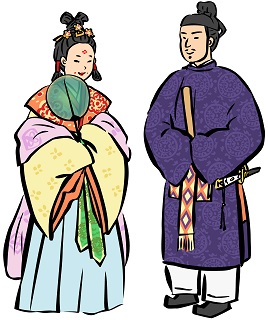 |
■Heian Period(平安時代)
In the Heian period (794-1185), kimonos were made using the "straight line cutting" method,
in which the cloth is cut and sewn together in straight lines, without being constrained by the lines of the wearer's body.
平安時代(794年〜1185年)に入ると、着る人の体の線にとらわれず、布地を直線に裁ち、縫(ぬ)い合わせる「直線裁(ちょくせんだち)」という方法で着物が作られるようになりました。
■Kamakura Period (鎌倉時代)
During the Kamakura (1185-1333) and Muromachi (1336-1573) periods, not only women but also men began to wear kimonos of gorgeous colors.
As the power of the samurai spread, the costumes worn on the battlefield became more colorful, expressing the individuality of each general.
鎌倉時代(1185年〜1333年)や室町時代(1336年〜1573年)になると、女性に限らず男性もまた華(はな)やかな色の着物を身につけるようになりました。武士の勢力が広がっていくにつれて、
戦地に着ていく衣装は、それぞれの大将の個性を主張したものとなり、あでやかであったと言います。
■Edo Period(江戸時代)
During the Edo period (1603-1867), under the stable samurai government of the Tokugawa family,
feudal lords were given fiefdoms throughout the country and were given autonomy under a clan system.
The kamishimo, or clan uniform, was a generic term for a jacket and hakama made of hemp fabric glued together so that the shoulders protruded,
and each clan had its own pattern.
江戸時代(1603年〜1867年)は安定した徳川家の武家政権の下、全国各地の大名が領地をあたえられ、自治を任せられる藩(はん)制度がしかれました。
藩の制服とも言える裃(かみしも)は、麻の生地を糊(のり)で固めて、肩(かた)の部分をはり出させた上着と袴(はかま)の総称(しょう)で、藩ごとに模様が決まっていました。
■From the Meiji Period to the Present(明治から現代)
During the Meiji Period (1868-1912), Japan was strongly influenced by foreign cultures.
The government, which was promoting westernization, issued a ”Clothing Ordinance” (there is no such law today) for bureaucrats and military personnel,
which required them to wear western-style clothing on official occasions. Since then,
the formal dress of kimono has been ”montsuki” for both men and women.
明治時代(1868年〜1912年)になると、日本は外国の文化の影響(えいきょう)を強く受けるようになりました。
西洋化を進める政府は、官僚(りょう)や軍人などに対して「正式の場では洋服を着用せよ」という衣服令(現在はこうした法律はありません)を出し、
庶民に対しては、着物を着る場合は、それぞれの家系を示すシンボルである家紋(もん)を入れた「紋付」が礼装と定められました。それ以来、着物での礼装は男女共に紋付となりました。
Copyright ©Japan Kimono store All Rights Reserved.



